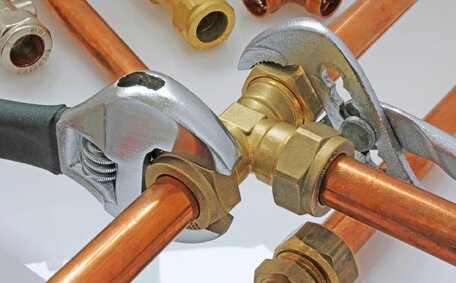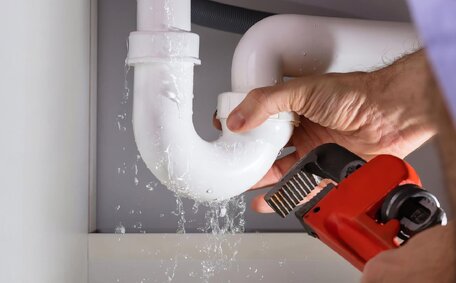Typical Cost Ranges for Replacing a Burst Pipe
Repair costs for a burst pipe differ greatly, influenced by damage severity, pipe location, among other factors:
- Small section replacement (less than 1 metre): $150 - $500
- Full pipe system replacement: $2,000 - $5,000+
Replacing just a small section of pipe tends to be more affordable, a factor which determines the cost repair for the total work, with costs influenced by accessibility, materials, and labour time. Full system replacements command a higher price due to the extensive work, including demolishing walls or ceilings.
Other variables that can impact your water pipe replacement costs include:
- - Type of pipe (copper, PVC etc.)
- - Pipe diameter/size
- - Number of fittings needed
- - Accessibility/location of the damaged section
- - Amount of drywall/structure removal required
- - Types of faucets and other plumbing fixtures
- - Type and extent of water damage
- - Emergency, weekend or after hours repairs
Given these variables, obtaining a detailed quote from a professional plumber after assessing the damage is essential.
Factors Influencing the Cost to Replace a Burst Pipe
There are several key factors that impact the cost of replacing a burst water pipe in your home:
- Pipe material - Copper pipes tend to be more expensive to purchase and replace than plastic pipes. Rectifying copper pipes also incurs more labour time.
- Pipe size and length - Larger diameter pipes and longer sections of damaged pipe will require more materials and time to replace, increasing costs.
- Accessibility - Burst pipes concealed behind walls or under floors may necessitate extensive demolition to access, which can substantially increase labour costs.
- Location/level - Work in confined or high areas may take longer, which could result in increased costs.
- Water damage extent - Severe water damage needing dry-out services, removal of waterlogged materials or reconstruction can add major costs.
- Type of valves/fittings - Replacing costly fixtures like pressure valves or tempering valves, among any other plumbing components, adds to the overall bill.
- Emergency/after hours repairs - Urgent repairs or call-outs on nights/weekends typically cost 50-100% more in labour due to penalty rates.
Professional on-site evaluations by licensed plumbers are vital as various factors influence cost estimates, particularly for burst water incidents.
Pipe Location and Accessibility
The location of a pipe burst plays a major role in determining the complexity and cost of repairing or replacing it. Easily accessible pipes often require less labour and materials, reducing the overall cost to repair them.
These pipes facilitate swift repairs, often in a few hours with minimal inconvenience, for small leaks or blocked drains.
In contrast, pipes concealed inside walls, under floors or underground can complicate repairs. Plumbers may need to cut large holes through drywall, remove sections of flooring, jackhammer concrete or excavate yards to repair burst sections. Demolition for repairs significantly increases labour times and associated costs, including material disposal and site clean-up.
Subsequent reconstruction efforts also affect the total cost.
The complexity and cost of repairs increase with the depth of buried pipes or their location in multi-storey buildings. Furthermore, specialised equipment is often required for underground excavation or working at heights. All these factors can push replacement costs into the thousands.
Extent of Damage and Repairs Needed
The severity of damage from burst pipes significantly influences repair costs; Minor leaks often need minimal repairs, whereas significant damage may warrant entire system replacements, incurring substantial costs.
Addressing leaks promptly can keep repair costs below $500, highlighting the importance of immediate action. Common minor repairs, with costs varying, encompass:
- Re-sealing leaking pipe joints
- Replacing short pipe sections
- Patching small holes
Substantial repairs for severe damage, like catastrophic failure of old pipes, start at $2,000, often soaring beyond $5,000. Some scenarios include:
- Replacing large portions of a pipe network
- Removing and reinstalling pipes in walls/floors
- Excavating and replacing underground water pipes
- Extensive drying out of waterlogged materials
- Structural work to repair flooded areas
In severe cases, homes need complete re-piping when systems are irreparable due to age or extensive damage, often exceeding $10,000.
Repair requirements are contingent on the pipe type, its accessibility, and the degree to which the damage affects building materials. Professional plumbers are best placed to thoroughly inspect and determine appropriate fix solutions once leak sources are controlled.
Choosing Replacement Materials
The materials chosen for replacing a burst pipe are critical to ensure durability and optimal performance. The type of material can also impact the overall project cost.
Some common pipe materials plumbers use for repairs and replacements include:
- Copper – Long-lasting and corrosion resistant but more expensive. Used for supply lines and drains.
- PVC (polyvinyl chloride) – Durable plastic piping that’s affordable and easy to install. Mainly used for drains.
- PEX (cross-linked polyethylene) – Flexible plastic tubing gaining popularity for hot and cold supply lines. Costs midpoint between copper and PVC.
- Galvanised steel – Once very common but prone to rust and scale build-up over time leading to leaks.
For significant replacements, using materials consistent with the existing system simplifies integration. However, upgrading to more modern, longer-lasting materials like PEX may be wise for older homes.
The tools and skill level required for installation should also be weighed up. PEX and PVC are relatively easy for plumbers to work with, while copper takes more experience and specialty tools like pipe cutters and bending equipment.
In the end, it is the role of licenced plumbers to evaluate the pipe’s condition and advise on suitable replacement materials. Having the correct pipes installed by qualified professionals ensures proper execution of the job and quality materials extend the system’s lifespan.
Signs of a Burst Pipe
There are several key signs indicating you may have a burst pipe in your home:
- Visible water leaks - Water dripping from ceilings, walls, under sinks, or outside around your home’s foundation.
- Low water pressure - Reduced flow from faucets and shower heads that continues to decrease over time.
- Discoloured water - Cloudy, muddy or sediment-filled water coming from faucets.
- Flooding - Water pooling in rooms or areas away from plumbing fixtures.
- Sinkholes or soft soil - Collapsed earth outside indicating an underground pipe may have burst.
- Unexplained high water bills - Much higher than normal usage pointing to a hidden leak.
If you notice such signs, shut off the main water supply immediately and contact a plumber to assess the damage.






